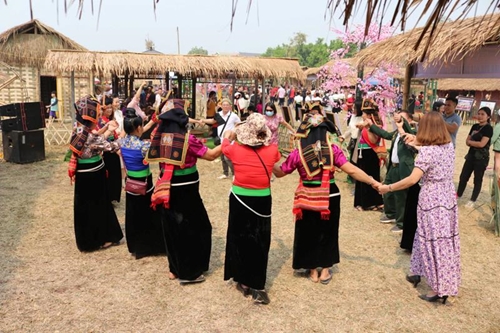Dien Bien province is home to 19 ethnic groups. Each group has their own cultural identity, creating cultural diversity for the province. One of the cultural values of ethnic groups is shown through festivals.
In the past, festivals in Dien Bien were mostly small-scaled, and held at the village level, by local residents themselves. Currently, many festivals of ethnic minority groups have been upheld and preserved. One of them is the rain praying ceremony of the Cong people; Klang Khua and Zùsu festivals of the H’mong people; the Khang people’s peace-praying ceremony called Xe-pang-a; rain praying ceremony of the Kho Mu people in the communes of Pa Thom, Muong Phang, and Muong Muon communes in Dien Bien district. A number of festivals are held at district and provincial levels, such as Ban Phu Citadel Festival in Dien Bien district; festival in Hero Vu A Dinh’s hometown of in Pu Nhung commune, Tuan Giao district; Xen Ban festival in the hamlets of U Va, Co My, and Noong Bua in Dien Bien district, to name but a few...
    |
 |
|
Tourists enjoy a Xoe Thai dance performance in Dien Bien province. |
Especially, Dien Bien province has two elements of intangible cultural heritage recognized by the United Nations Educational, Scientific and Cultural Organization (UNESCO), which are Xoe Thai dance and Then singing of the Tay, Nung, and Thai ethnic groups. Besides, the province also has 18 cultural heritage sites.
According to Assoc. Prof., Dr. Pham Lan Oanh from the National Institute of Culture and Arts and Dr. Do Cam Tho from the Vietnam National Tourism Administration, cultural tourism should be developed in Dien Bien province. This is the community-based tourism in combination with learning about the ethnic minority groups’ habits, production and religious activities in Dien Bien. Therefore, promoting community-based tourism will help the locality preserve traditional culture.
Twenty years ago, Dien Bien province selected the eight hamlets of Noong Bua, Co Mỵ, Ten, U Va, Pe Luong, Phieng Loi, Him Lam 2, and Men, to develop into a cultural model to serve tourists. Accordingly, each hamlet was supported to build a community cultural house, and chose households with suitable conditions to build high standard sanitary facilities. Functional agencies organized refresher courses to provide knowledge about community-based tourism for people in these hamlets. They also established teams of 15-20 people to be in charge of working as local tour guides, serving food, conducting art performances, organizing traditional folk games, and ensuring security for visitors.
Currently, Dien Bien province has 12 cultural and tourist hamlets, six homestay facilities, such as Phieng Loi hamlet in Thanh Minh commune and Che Can hamlet in Muong Phang commune, Dien Bien Phu city; Men hamlet in Thanh Nua commune, Dien Bien district; Na Su hamlet, Cha Nua commune, Nam Po district. Among them, Na Su hamlet is the first community-based tourism destination in the border district of Nam Po. Visiting the hamlet, tourists can explore and experience the life of the Thai ethnic group; enjoy local cuisine, and rest at households in the hamlet.
According to Ms. Le Thi Thuy Dung from the Su That (Truth) National Political Publishing House, domestic and foreign tourists know about Na Su via its community-based tourism model in association with upholding and promoting Thai ethnic culture.
In early March 2023, the Dien Bien provincial People’s Committee approved its tourism development project until 2025, with the vision to 2030. Accordingly, the province will develop tourism products via three main pillars, one of which is developing community-based tourism model to learn about the cultural identities of ethnic minority groups, preserve and promote intangible cultural values and folk music, and enjoy local cuisine, OCOP (one commune, one product) products, while promoting eco-tourism products, among others.
At present, Dien Bien province’s community-based tourism business is following homestay model. Local people have used their traditional but newly-repaired houses to attract and serve tourists. Top destinations in this field are Phieng Loi, Che Can and Keo hamlets in Dien Bien Phu city; Ta Ko Nhu hamlet in Muong Nhe district; Na Su hamet in Nam Po district; Na Sang II hamlet in Dien Bien district.
According to Prof., Dr. Truong Quoc Binh from the National Council for Cultural Heritage, Dien Bien was named by King Thieu Tri in 1841 with the meaning of a strong border area. Not only is it a historical destination that attracts tourists to the Special National Historical Relic Site of Dien Bien Phu Battlefield, which is dedicated to the Dien Bien Phu Victory, Dien Bien province is also an attractive destination for natural and cultural tourism. Thus, the province is bringing into play such potential to become an attractive tourism destination in the region by 2025.
Translated by Minh Anh